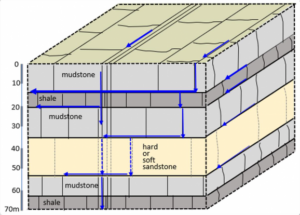5.1 Fracture Network and Conceptual Flow Models in Sedimentary Rocks
In the stratabound fracture networks typical of sedimentary rocks, horizontal permeability parallel to bedding-plane fractures can be much greater than the transversal permeability, because the latter depends on fractures that are generally discontinuous and frequently limited to individual layers. For example, in the Passaic Formation, Newark Basin, Michalski & Britton (1997) concluded that the bedding-plane partings tend to provide principal groundwater flow pathways, and a few of these fractures can constitute discrete units of a multiunit aquifer system formed by a sequence of mudstones and shales. The distribution of transmissive zones can be restricted to a few bedding-plane fractures that may vary with the sedimentary rock type as demonstrated by Morin and others (2007). Transmissive zones are more numerous in hard sandstones than in soft ones because soft sandstones generally have the smaller permeability perpendicular to bedding (Figure 65). Lithology often controls the permeability perpendicular to bedding, which depends on the flow paths winding along joints and bedding-plane fractures (Morin et al., 2007). Close to the surface, the transmissivity of the bedding-plane partings is large but significantly decreases from 10 to 25 m in depth (Morin et al., 1997; Morin & Savage, 2003). A high-angle fracture set is also part of the system, being approximately orthogonal to the bedding fractures. Its transmissivity (about half of the bedding fractures) showed no apparent dependence upon depth (Morin et al., 1997). However, this behavior depends on the orientation of the present tectonic stresses (Morin & Savage 2003).

Figure 65 – Photograph of a sandstone covered by basalt. Orthogonal fractures (striking ~N20E and ~N70W) occur only in the upper portion of the sandstone layer that was indurated by cementation caused by the percolation of fluids derived from the basalt lava. The soft sandstone (lower part of the layer) is devoid of fractures, illustrating that hard sandstones are more likely to have a denser fracture network than soft ones. The contact between the two types of sandstones is sharp. (photograph: Francisco Negri, near Botucatu city, São Paulo State, Brazil).
For a well-bedded, flat-lying Ordovician dolostone observed in a quarry approximately 60 m deep large-extent, bedding-plane fractures with high hydraulic conductivity (K) represent major groundwater flow paths (Lemieux et al., 2006). Two high-permeability bedding planes occur at depths of 13 m and 24 m. Four sets of vertical fractures of lower K provide vertical connections. In general, these terminate at the bedding planes forming a stratabound/hierarchical network as shown in Figure 42 (Hooker et al., 2013). Parker and others (2018) also assign the high bulk K of a dolostone aquifer to the combination of fractures along and parallel to the bedding planes, stylolites (serrated surfaces within a rock mass where mineral material has been removed by pressure dissolution), and high-angle fractures. These dolostone conceptual models are consistent in that both rely on highly permeable shallow horizontal openings connected by vertical fractures.
The conceptual model shown in Figure 66 summarizes relevant characteristics of an aquifer formed by fractured sedimentary rock, as described in Morin and others (1997), Morin & Savage (2003) and Lemieux and others (2006).

Figure 66 – Conceptual model of a stratabound/hierarchical fracture network Figure 42) in a sedimentary aquifer formed by mudstone, shale, and sandstone layers. The following aspects are common in nearly all of these systems: 1) bed partings (fractures along the layer contacts) may form aquifer units; 2) close to the surface, the permeability (proportional to the thickness of the blue arrows) of these partings is larger than that of the vertical fractures and decreases with depth; 3) transmissive throughgoing vertical fracture zones are important for flow and are sparser than the bed-confined fractures; 4) in the sandstone layer the number of fractures (dashed lines) will depend on the toughness of the rock and tends to be larger in harder sandstones than in softer sandstones; 5) vertical flow winds its way along horizontal and vertical fractures. The illustrated depths of the more transmissive horizontal fractures are based on data from Morin and others (1997), Morin & Savage (2003) and Lemieux and others (2006).
The systematic and cross joint pattern (Figure 43b and Figure 44) forms a well-connected fracture network and the flow configuration may be strongly affected by the aperture range of each set. If the systematic fractures bear a higher hydraulic connectivity than the cross joints, the flow will take place over large horizontal distances along the systematic fractures; the opposite aperture relationship will interrupt horizonal flow. The vertical extension of flow greatly depends on how far the fractures propagate across the existing sedimentary layers.
Surrette and others (2008) define hydrostructural domains in order to characterize permeability at a regional scale, where fracture distributions are heterogeneous. The domains are partly lithology-dependent and reflect changes in fracture intensity within the rock mass. For the southern Gulf Islands, British Columbia, Canada, they defined three domains in decreasing order of potential permeability:
- fault and fracture zone domain;
- highly fractured interbedded mudstone and sandstone domain; and,
- less fractured sandstone domain.
It was concluded that the relative potential transmissivity values, derived from models based on the domains, show good spatial agreement with transmissivity values obtained from pumping tests at selected sites.
